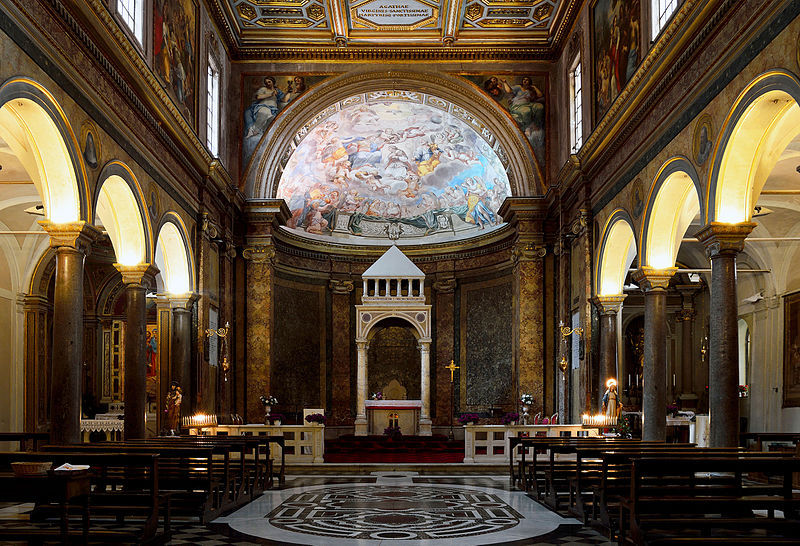
Profile of Rome
As I’ve mentioned elsewhere, pastoral care in early Christian Rome was looked after by the tituli. These numbered twenty in the third century and increased to twenty-eight during the eighth century. Larger, more impressive churches were designated basilicas, five of which were known as “patriarchal” (St Peter, St Paul, St Lawrence, Santa Maria Maggiore and San Salvatore in the Lateran). The pope lived at the Lateran palace (occasionally [640] looted by Byzantines who feared the pope might “lose” the emperor’s wages) where he divided the city into seven districts under the responsibility of as many deacons known as the diaconi regionarii.
Deacons helped the poor and managed church properties in their respective districts. Originally assisted by notarii, these bureaucratic hangovers from late antiquity were organized into scholae (perhaps best defined as gangs, clubs or guilds) each of which was led by a primicerius and secundicerius. The deacons also had the assistance of defensores who were like local church solicitors that confronted unscrupulous imperial agents and represented the church in minor cases.

By the seventh century, the main officers of papal administration were the primicerius, secundicerius notariorum, primicerius defensorum, vicedominus (staff manager), sacellarius (chancellor), vestararius (wardrobe manager) and the nomenclaror (master of ceremonies). By the eighth century the superista, the commander of the papal militia was part of the crew too. Administering the papacy’s wealth, a rector (typically a subdeacon) ran each patrimony and supervised the urban granaries. Labelled “diaconiae,” they were not charitable foundations on the Byzantine model but distributed grain to the population. By the early ninth century there were eighteen of them. Priests were supported on the system of quarta (a quarter to bishop, clergy, poor and edifices respectively), which had been instituted officially in the fifth century. This was a slightly humbler arrangement that in the East where priests also received a stipend from the income of their dioceses, whose amount was calibrated to the importance of their offices.

Byzantine Monasticism in Rome
The Byzantine impact on Rome’s monastic scene tends to be underplayed. This is bizarre given some Latin monasteries, such as the Gregorian foundation of St Andrew in Clivo Scauri, even became Byzantine. Elsewhere the trend encouraged the development hermitical cells, which flourished at the monastery of St Caesarius in Palatio. Epigraphic evidence also suggests the presence of a stylite atop Trajan’s column (just as Daniel and Luke lived among the Constantinople-adjacent skies of Anaplous and Chalcedon respectively).
Pointedly, the permeation didn’t go both ways. There was almost no Latin monastic presence in Constantinople until the Italians’ later commercial dominance. Migration flowed from East to West after the Iranian invasion, Islamic deluge, and later the iconoclastic persecution. Following these cataclysms, St Sabas was founded on the Aventine Hill by monks from the St Sabas Palestinian Lavra, Byzantine monks from Cilicia settled in the monastery of St Anastasius ad Aquas Salvias near the basilica of St Paul outside the Walls, others occupied St Agatha of the Suburra on the Quirinal Hill, and another group took over St Erasmus at Celio. Armenian monks also replaced Latin ones at the monasterium Renati on the Esquiline Hill.
Some Byzantine zones were ephemeral. They tended to be attached to the missions of the (other) four patriarchates. Any enduring Byzantinisation was the result of refugees who migrated en bloc. From the seventh to the ninth century, there were at least thirteen or fourteen Byzantine monasteries in Rome. And while this number obviously paled in comparison to the Latin equivalents, it is notable that some of the more prestigious monastic foundations (St Sabas on the Aventine, St Anastasius ad Aquas Salvias and St Sylvester in Capite, for example) were Byzantine.

The reputation many of these monasteries achieved was enviable. Popes even assigned their own personal foundations to them, as Paul I did with St Sylvester in Capite and Gregory II with St Agatha at Suburra. Paschal I established Byzantine monks at the titulus of St Praxedis (where St Constantine-Cyril took his monastic vows before his death). Leo IV did the same at Sts Stephen and Cassian. And Byzantines officiated at many basilicas and titulae, including St Lawrence at Verano. Papal liturgies, probably preserving their oldest forms, still recited readings from the Gospel in Greek.
Begging for better historical records is a fool’s game. But it would be nice to have sources that explained how those in Rome lost their aptitude for Greek (500-1000) despite a strong Hellenic presence. It’d also be good to know if or how the Hellenes educated their brethren on doctrinal delicacies such as the Monothelite crisis, or iconoclasm, as well as whether they trained apocrisarii, and so on.
Comentários